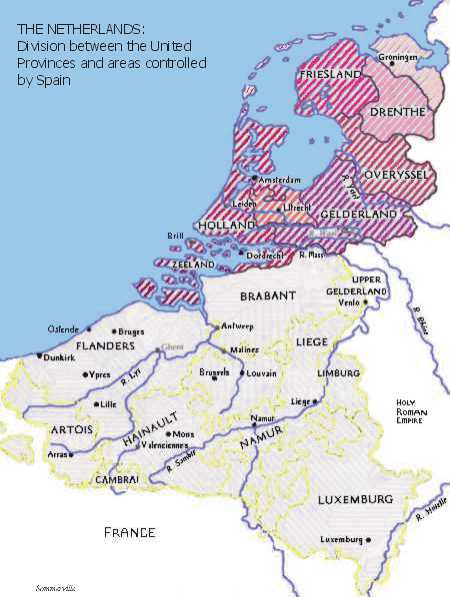![]()
Tue, Sept 13, 2011 | Asia Times Online | By Spengler

Bartholomeus van der Helst - Banquet of the Amsterdam Civic Guard in Celebration of the Peace of Münster. 1648: The Treaty of Münster and Osnabrück is signed, ending the Eighty Years' War: The Dutch Republic is recognised as an independent country. (www.militaryphotos.net)
Israel as the Dutch Republic in the Thirty Years War
Originally published in the Asia Times Online.
A small country, its land reclaimed from a hostile nature, fights for survival against overwhelming odds for 80 years. Surrounded by enemies dedicated to its destruction, it fields the world’s most innovative army and beats them. Despite three generations of war, the arts, sciences and commerce flourish. Its population grows quickly while the conflict empties the failed states that surround it. And it becomes a beacon of hope for the cause of freedom.
I refer not to Israel, but to the Dutch Republic of the 17th century, whose struggle for freedom against Spain set the precedent for the American Revolution. The final three decades of the Eighty Years War (1568-1648) coincided with the terrible Thirty Years War.
In 1600, a million-and-a-half Dutchmen faced an Austrian-Spanish alliance with more than 10 times their population; by 1648, the people of the Netherlands numbered two million, while the Spanish and Austrians had perhaps a quarter of their people. Holland had become the richest land in the world, with 16,000 merchant vessels supplying a global trading empire, graced by artists like Rembrandt and Vermeer and scientists like Huygens and Leeuwenhoek.
We might speak of the “isolation” of the Dutch at the outset of the Thirty Years War, although England backed them from the outset; that is why Philip II of Spain launched the Great Armada in 1588. Holland faced more formidable enemies than modern Israel; in place of the feckless Third World armies of Egypt and Syria, the Dutch fought Spain, the superpower of the 16th century, with the world’s best professional infantry bought with New World loot. The superior Dutch navy disrupted Spanish lines of communication, and a new kind of mobile infantry defeated the static Spanish square with continuous musket fire.
Holland confronted a formidable adversary, determined to extirpate its Protestant religion; Israel faces a group of failed or gradually-failing states whose capacity to make war is eroding. Seven months after the start of the Arab uprisings, Israel’s position is a paradox.
The prospects for a formal peace are the worst since 1977, while Israel’s military position has improved. The Syrian army is too busy butchering protesters to attack the Jewish state, and the uncertain position of the Bashar al-Assad regime weakens its Lebanese client Hezbollah. Egyptian popular sentiment has turned nastily against Israel, but the last thing the Egyptian army needs at the moment is a war with Israel that it inevitably would lose.
[…]

The Dutch had revolted against the Spanish Crown in 1568 and proclaimed their independence in 1581. However, it was not until the Twelve Years Truce of 1609 that war with Spanish forces ceased (temporarily), and not until 1648 that Spain finally acknowledged Dutch independence. Small in territory, the United Provinces grew extremely wealthy on the profits from shipping, fishing, extensive trade and efficient agriculture. (http://history.wisc.edu)
A country that knows it must fight daily for its existence may thrive under interrupted stress. That is unimaginable for the Israeli peace camp, which dwindled into political insignificance after the Intifada of 2000, as well as for America’s liberal Jews. But most Israelis seem to have adapted well to a long-term war regime.
The Dutch certainly did. When the Thirty Years War began in 1618 over Bohemia’s attempts to cast off Austrian rule, Holland knew that Spain would take the opportunity to settle accounts with its breakaway Protestant province. Expecting a Spanish invasion, the English Separatists living in Holland decided instead to become Pilgrims to the New World. ”The Spaniard,” their leader William Bradford wrote in 1618, ”might prove as cruel as the savages of America, and the famine and pestilence as sore here as there.”
A year after the Mayflower sailed to Plymouth Rock in 1620, Spain sent an army into Holland, and in 1625 the Spanish took the great Dutch fortress of Breda, just 90 kilometers from Amsterdam; Velasquez’s canvas depicting the city’s surrender hangs in Madrid’s Prado Museum. The Dutch defenders kept the Spanish army away from their coastal cities only by opening the dikes and flooding the countryside. Had the Pilgrims stayed and the Spanish won, the Pilgrims likely would have been burned as heretics.
Spain embargoed Dutch trade and succeeded in damaging its economy, although Dutch attacks on the Spanish fleets bringing treasure from the New World provided some breathing room. One by one, Holland saw its German and Danish Protestant allies beaten by Austro-Spanish alliance, and by 1625 was fighting alone. By the late 1620s, though, Holland was winning a war of attrition against overextended Spain, and could match the Spanish in the field.
The military balance remained precarious; in 1629 the Spanish army within 40 kilometers of Amsterdam. The turning point came in 1632, when the Dutch took the Flemish city of Maastricht, breaking Spain’s hold on the Catholic Low Countries. When Spain and France went to war in 1635, the victorious Netherlands dominated European trade and its “Golden Age” reached fruition.
Holland boasted the world’s strongest navy and a dominant position in world shipping trade, and its home provinces became impregnable.
The Dutch were smart and tough, but they beat the Spanish empire in large part by being better than their adversaries. The Dutch republic offered Europe’s first example of religious toleration. Iberian Jews and French Huguenot found refuge in Holland against religious toleration, and the skilled immigrants made invaluable contributions to the Dutch economic miracle – something like the Russian immigrants to Israel today.
When Dutch armies invaded the Spanish Netherlands (now Belgium) they offered religious freedom to the Catholics they absorbed. Countries that attract talented people have an enormous advantage over countries that drive them out.
Without stretching the analogy too far, the religious conflict that surrounded 17th century Holland have something in common with today’s Middle East. Americans know almost nothing of the Thirty Years War; not a single Hollywood film nor one popular novel recounts its major events. It is a tale of unrelenting misery, of battles and marches and countermarches that left nearly half of Central Europe dead.
[…]



 RSS
RSS










Israel as the Dutch Republic in the Thirty Years War | Middle East, Israel, Arab World, Southwest As http://t.co/Tgf35TbV
Israel as the Dutch Republic in the Thirty Years War | Middle East, Israel, Arab World, Southwest As http://t.co/Tgf35TbV
RT “@CrethiPlethi: Israel as the Dutch Republic in the Thirty Years War | Middle East, Israel, Arab World, Southwest As http://t.co/tkcR6d5g